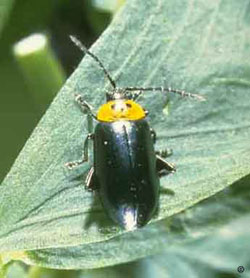What crops do flea beetles attack?
There are several flea beetle species in Colorado. These beetles commonly attack vegetable plants including tomatoes, potatoes, peppers, eggplant, cabbage, broccoli, beans, radishes, beets and lettuce.
What do flea beetles look like?

Adult flea beetles are small and shiny. When disturbed, they jump. The western cabbage flea beetle, pale-striped flea beetle and western potato flea beetle are the most damaging species.
What do flea beetles do to plants?
They eat small holes in leaves and, during heavy infestations, the plant’s growth is greatly reduced and it may die.
What do flea beetle larvae look like?
Flea beetles overwinter as adults under plant debris or weeds adjacent to the garden. The larvae are white and worm-like and are found on plant roots. Larvae cause little damage, except for the western potato flea beetle, which tunnels into tubers. There are usually one to two generations of beetles in a year.
How can I prevent flea beetles?
Use healthy, actively growing transplants and encourage their rapid establishment to prevent flea beetle attacks. Floating row covers also can exclude flea beetles from the garden. When necessary, garden insecticides containing carbaryl (Sevin), spinosad, bifenthrin and permethrin can be used to control heavy infestations.
For more information, see the following Colorado State University Extension fact sheet(s).



